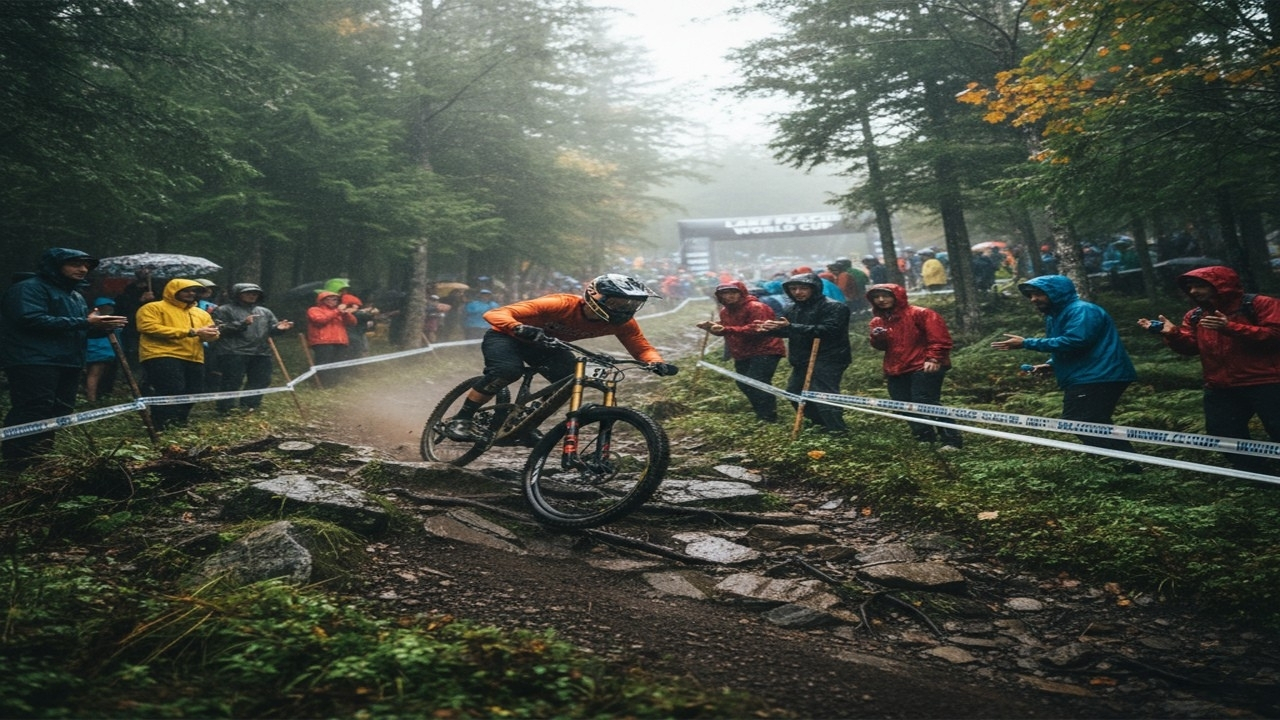The 2025 Lake Placid Downhill World Cup Qualifying round marked one of the most anticipated moments of the mountain biking season. After years of speculation about whether Lake Placid would rejoin the global racing calendar, the Adirondack mountain town delivered an event that exceeded all expectations. Known for its Olympic heritage and challenging natural terrain, Lake Placid offered an ideal stage for world-class athletes to test their limits against a course that was both technically demanding and visually stunning.
The return of downhill racing to this historic venue represented more than just another World Cup qualifier-it was a symbolic reconnection between the sport and one of its most scenic North American backdrops. From elite professionals to passionate fans, everyone arrived with a sense of excitement and nostalgia, ready to witness history being made once again on the legendary slopes of Whiteface Mountain.
The Course That Tested Every Skill
The 2025 Lake Placid course was meticulously designed to challenge riders from the first drop to the final sprint. Stretching approximately 2.8 kilometers, it descended over 500 meters in elevation, combining steep natural gradients with newly engineered features. The upper section was characterized by jagged rock gardens, slippery roots, and off-camber corners that punished even the smallest mistakes. Riders needed flawless balance and perfect timing to maintain momentum through the rough terrain.
As racers entered the midsection, the trail transitioned into faster, flowing lines with several large jumps and doubles that rewarded precision and confidence. These features were a crowd favorite, as riders showcased their aerial control and aggressive style. The final stretch, known locally as “The Plunge,” was an unforgiving series of tight switchbacks leading to the finish area, where riders had to remain focused despite fatigue and noise from roaring spectators.
The course was praised for maintaining a natural feel while incorporating modern race flow. Its combination of technical sections, high-speed stretches, and unpredictable traction made it a complete test of skill, endurance, and bike setup.
A Battle Against the Elements
The weather played a decisive role throughout qualifying day. The morning began with cool, dry conditions, and early riders enjoyed a fast, grippy surface that allowed for precise line choices. However, as the day progressed, clouds rolled in, and a light drizzle began to fall over the mountain. The moisture quickly transformed the upper rock gardens into slick traps, forcing later riders to adapt mid-run.
Those who qualified early benefitted from the drier track, while others had to wrestle with deteriorating conditions. Tire changes became a frequent sight in the pits, as teams scrambled to adjust compounds for better grip. Suspension setups were tweaked between runs to accommodate the increasingly soft and rutted surface.
By late afternoon, the once-dusty trail had turned muddy and treacherous. Riders who managed to maintain control in these conditions showcased remarkable adaptability and composure. The unpredictability of the weather ensured that every second counted, making the qualifying session one of the most dramatic of the season.
Men’s Qualifying Results and Highlights
The men’s field delivered a thrilling show of speed and precision. Defending champion Loris Vergier proved once again why he is among the sport’s elite, setting a blistering pace with a time of 3:05.62. His run was nearly flawless, combining smooth line selection with confident cornering. Vergier’s mastery of technical terrain shone through the most challenging rock sections, giving him a narrow but decisive lead.
American star Dakotah Norton thrilled the home crowd with an aggressive and fast-paced run that earned him second place, just 0.47 seconds behind Vergier. His performance drew loud cheers from fans who had gathered along the course to support their national favorite. Norton’s bold style on the jumps and his precision through the wet corners highlighted his growing reputation as a serious title contender.
Canada’s Finn Iles took third place with a time of 3:06.58, showcasing his trademark composure and clean technique. Australian veteran Troy Brosnan followed closely in fourth, while British rider Bernard Kerr rounded out the top five with one of the most visually spectacular runs of the day.
The top ten was completed by a mix of established names and emerging talents, including Jordan Williams, Amaury Pierron, Jackson Goldstone, Andreas Kolb, and Greg Minnaar. The time difference between first and tenth was less than two seconds, emphasizing the intensity and competitiveness of this year’s World Cup season.
Women’s Qualifying Results and Standout Riders
In the women’s field, Valentina Höll continued her dominant run of form by setting the fastest qualifying time at 3:29.78. Her ability to maintain control and speed through the treacherous upper rock gardens distinguished her from the rest of the field. Höll’s combination of technical confidence and mental focus has become a benchmark in modern downhill racing.
British rider Tahnee Seagrave, returning from a long recovery period, produced an inspiring performance to finish second, less than a second behind Höll. Her comeback was one of the most talked-about stories of the weekend, proving that experience and determination can overcome adversity.
Camille Balanche from Switzerland secured third place with her usual consistency and smart line choices. French racer Marine Cabirou and German contender Nina Hoffmann completed the top five, both delivering solid runs in the increasingly slippery conditions.
American rider Anna Newkirk was a crowd favorite, finishing within the top ten and earning loud cheers from local fans. Her confident approach through the high-speed midsection demonstrated that North America’s next generation of riders is ready to challenge the European dominance in the sport.
The Energy of the Crowd and the Festival Atmosphere
Lake Placid came alive with energy throughout the qualifying weekend. Thousands of spectators filled the hillsides, ringing cowbells, waving flags, and cheering for every rider who dropped in. The village center transformed into a lively hub of celebration, with local food vendors, music performances, and bike exhibitions creating a festival-like atmosphere.
The combination of local pride and international competition gave the event a unique charm. Families camped near the trails, amateur cyclists explored the area’s scenic paths, and former Olympians were spotted among the spectators. The sense of community and excitement reaffirmed Lake Placid’s reputation as one of the most passionate sports destinations in North America.
Many riders commented that the energy from the crowd pushed them to perform at their best. The noise of fans echoing through the forest added to the adrenaline, creating an environment that every racer dreams of experiencing.
Equipment, Bike Setups, and Technical Insights
Behind every fast run was a carefully tuned machine. Teams arrived with customized setups tailored to Lake Placid’s demanding course. Suspension adjustments were a critical factor, as riders balanced the need for traction on the upper technical sections with the desire for stability and speed on the open, high-velocity stretches.
Tire choice became a major strategic decision. Early qualifiers favored medium-compound tires for versatility, while later riders, facing rain and mud, switched to softer compounds to maximize grip. Mechanics worked tirelessly between runs, changing wheelsets, tuning brakes, and cleaning drivetrains clogged with dirt and debris.
Many teams also tested new prototype parts, including lighter carbon components and refined damping systems designed to improve responsiveness on rugged terrain. The competition between manufacturers was nearly as intense as the racing itself, with each team striving to gain even the smallest mechanical advantage.
Breakthrough Performances and Rising Stars
Beyond the headline results, the 2025 Lake Placid qualifier featured several breakout performances that captured attention. French newcomer Max Alran delivered an impressive top-15 finish, surprising both fans and analysts with his precision on a course notorious for punishing inexperience.
In the women’s division, Eleonora Farina of Italy posted a top-eight result that highlighted her progress and determination. American junior rider Luke McDowell narrowly missed the finals cut but demonstrated exceptional potential for future seasons. These rising talents represent the evolving landscape of downhill racing, where young riders are rapidly closing the gap on established veterans.
The diversity of competitors reflected the sport’s growing global reach. Riders from South America, Asia, and Eastern Europe made notable appearances, further solidifying downhill racing’s status as an international phenomenon.
Preparation, Focus, and the Mental Game
Downhill racing is as much a mental battle as it is a physical one. In the days leading up to qualifying, riders spent hours walking the course, memorizing every rock, root, and rut. Many practiced visualization techniques, mentally rehearsing their lines until they could ride them instinctively.
Preparation extended far beyond the race weekend. Most competitors had spent the off-season training on similar terrains, building strength, balance, and reaction time. Nutrition, rest, and psychological conditioning all played vital roles in helping athletes maintain focus under immense pressure.
When a single run determines success or failure, mental clarity becomes the most valuable asset. Riders often spoke about entering a state of flow during their best performances-a focused calm that allows them to react naturally despite the chaos around them. The Lake Placid qualifier showcased how mental discipline separates good riders from great ones.
Lake Placid’s Place in the Future of Downhill Racing
The success of the 2025 qualifier has reinforced Lake Placid’s position as one of the premier destinations in the global downhill circuit. The combination of world-class facilities, challenging terrain, and passionate community support makes it a venue worthy of continued inclusion in future World Cup calendars.
Local organizers have expressed strong interest in hosting more international events, and the infrastructure improvements made for this year’s race have laid the groundwork for sustained growth. The event also boosted regional tourism, attracting visitors who contributed significantly to the local economy while celebrating the spirit of adventure sports.
Lake Placid has proven that it can deliver a racing experience that blends technical precision with natural beauty. For riders, it’s a course that demands respect. For fans, it’s a spectacle of courage and speed set against a breathtaking mountain backdrop.
Final Reflections and Expectations Ahead
As qualifying concluded, anticipation turned toward the finals and the rest of the 2025 World Cup season. With margins so tight among the top riders, every round promises new battles and shifting momentum. Loris Vergier’s performance reaffirmed his elite status, but challengers like Dakotah Norton and Finn Iles are clearly ready to contest his dominance.
In the women’s field, Valentina Höll remains the rider to beat, though Tahnee Seagrave’s resurgence and the steady form of Balanche and Cabirou ensure a fiercely competitive season ahead.
The Lake Placid round was more than just a qualifying event-it was a celebration of the sport’s progression, resilience, and global appeal. From the roar of the crowd to the precision of the riders, every moment captured what makes downhill racing one of the most exhilarating disciplines in cycling.
As the sun set behind the Adirondack peaks, it was clear that Lake Placid had reclaimed its place among the legendary venues of mountain biking. The world’s best had come, conquered, and left inspired, setting the tone for a season that promises to push the limits of what’s possible on two wheels.

